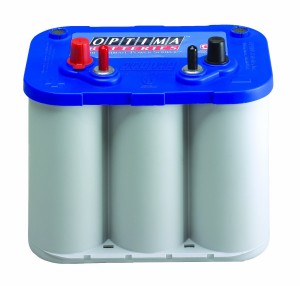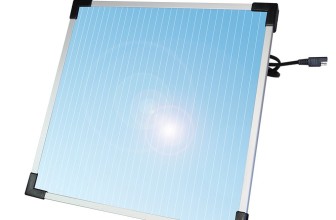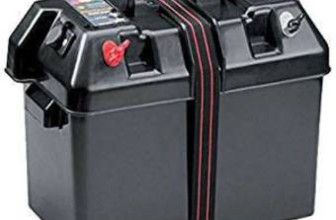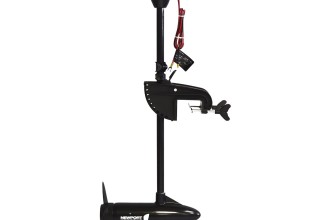You cannot run a sizable boat without the best marine battery. Sometimes you require two of them – one with enough cold cranking amps to start the engine and the other to power appliances on the boat. Some all-in-one batteries aren’t as good as a standalone, dedicated battery for each purpose, but they’ll do in a pinch.
Choosing the best marine battery is not the easiest thing to do. It certainly has to be recently produced because even a battery that is already a year old will provide a lower battery capacity than it had when it left the factory.
Here are a few Marine Batteries reviews which are considered to be the best ones in the Present Market.

- Optima Batteries 8016-103-FFP D34M Blue Deep Cycle Marine Battery
- Voltage - 12V
- 750 cold Cranking Amps
- 2 Hour Reserve Capacity
- Star Rating- 4.6

- Exide Edge FP-AGM24DP Flat Plate AGM Sealed Marine Battery
- Voltage - 12V
- 775 Cold Cranking Amps
- Up to 145 minutes of reserve capacity
- Star Rating-4.4

- Optima Batteries 8027-127-FFP D27M BlueTop Starting and Deep Cycle Marine Battery
- Voltage - 12V
- 1000 Amp Hours
- Pure lead spiralcell design,superior vibration resistance
- Star Rating- 4.5

- Optima Batteries 8040-218 D35 YellowTop Dual Purpose Battery
- Voltage - 12V
- 650 Cold Cranking Amps
- 98 minutes reserve capacity for constant performance
- Star Rating- 4.4

- Optima Batteries 8006-006-FFP 34M BlueTop Marine Starting Battery
- Voltage - 12V
- 800 Cold Cranking Amps
- Reserve capacity of 100 minutes for constant performance
- Star Rating- 4.7
Best Marine Battery Reviews 2023
Optima Batteries 8016-103 D34M BlueTop Starting and Deep Cycle Marine Battery
The Optima Batteries 8016-103 D34M is a dual-purpose battery that offers both engines starting with 750 cold-cranking amps and continual operation for reliable appliance operations on the boat.
The 55 Ah C20 battery capacity is plenty for your boats. One of the key features of Optima batteries is their ability to withstand strong shakes and movement on the boat without losing power at a critical time. It also weighs under 44 pounds, so it’s not too heavy on a mounting system to stay in place during rougher seas.
The reserve capacity is a pleasing 120-minutes at the standard tested 80-degrees Fahrenheit with a steady 25-amp discharge rate. This will run a trolling motor or other equipment for a good amount of time for a short trip or when an engine cuts out mid-way and a trolling motor must be deployed.
The absorbent glass mat (AGM) battery type is the zero maintenance one. Boat owners must be mindful never to overcharge an AGM battery as it’s susceptible to damage if they do. But it’s still far improved than using older battery technology that requires awkward maintenance to keep running. Two-year warranty provided.
- Spiral Cell battery technology
- Dual-purpose battery
- 750 cold-cranking amps for reliable engine starts
- 120-minutes reserve capacity
- Protected from spills
- Requires no maintenance
- Use in an RV or a boat
- Highly resistant to vibration
- Two-year warranty
- Small risk of damage due to overcharging the AGM battery
Optima Batteries 8006-006 34M BlueTop Marine Starting Battery
The Optima 8006-006 34M BlueTopbattery for boats and RVs is a starting battery. It has slightly more cold cranking amps at 800 of them (the marine cranking amps is rated at an even 1,000). However, the reserve capacity is a lower 100 minutes for a smoothed-out performance. Effectively, this battery will start a slightly more powerful engine but won’t keep it running for as long as the 8016-103 D34M also from Optima.
The 12-volt battery handles vibrations up to 15 times as well as other brands which is a significant selling point here. It has durable stainless-steel posts to attach metal grips to access the charge. The weight comes in at 38.4-pounds which makes it over 10 percent lighter than the 8016-103 D34M model. Fitting this battery, it’s less likely to slip out as there is less weight bearing down.
The distinctive blue top and grey plastic are thick enough to tolerate unfriendly weather out at sea. The AGM technology that’s used here ensures no maintenance issues are present. However, the battery will take between 6-12 hours to fully charge depending on the charging rate and how drained the battery was when starting to recharge it.
A two-year warranty is provided too.
- BlueTopstarting battery
- 800 cold-cranking amps (1,000 marine cranking amps) for the high powered start
- 100-minutes of powered reserve capacity
- Spiral Cell technology that’s durable
- AGM battery technology for no-fuss management
- 6-12 hours charging time
- Under 39 pounds
- Leakproof and handles weather well
- Two-year warranty
- Less capacity that some other marine batteries
Exide XMC-31 MEGACYCLE AGM-200 Sealed Maintenance Free (AGM) Marine Battery
The Exide XMC-31 MEGACYCLE AGM-200 is a high capacity high-capacity battery that’s not likely to let you down. It has 925 cold-cranking amps (1,110 marine cranking ones) to get hungry engines started up reliably. It also provides a reserve capacity of 200-minutes which is considerably longer than both of the Optima batteries reviewed above.
The AGM battery is sealed and doesn’t require any maintenance over time. You do have to be careful not to overcharge it, but most boat owners understand the sensitivity of certain types of batteries and monitor the charging process with care.
Exide uses its compression technology to prevent the battery parts from being adversely affected by excessive vibrations on the boat whether during transportation down to the boat launch or on the water.
A two-year warranty covers your purchase from the date it was completed.
- Dual-purpose battery
- 925 cold-cranking amps (1,110 marine cranking ones)
- Impressive 220-minutes of reserve capacity
- Solid housing to prevent vibrations affecting the internal parts
- AGM battery technology to prevent vibrations causing any issues
- Carry strap provided on the top
- Takes longer to recharge due to the higher capacity
- Not as well-known as the Optima brand
Vmaxtanks MR107 12V 85AH Marine AGM SLA Deep Cycle Battery | BCI Group 24
The Vmaxtanks MR107 is a deep cycle battery used for powering the boat, not starting it up. You’ll need a separate starter battery to get the engine going.
The battery is intended for use with trolling motors that have between 30 and 55 pounds of thrust. More powerful trolling motors will burn through the battery capacity faster.
The AGM 12-volt battery is a deep cycle type with an 85 Ah capacity. The lead-tin materials used to benefit from a special suspension system with electrolytes to get the most out of the battery. It doesn’t require additional liquid, electrolyte or gel to be added because it is purer AGM technology. The battery is heavily sealed and is leakproof. It weighs in at a hefty 55 pounds. Just do not overcharge the battery!
The operating time is expected to be over 7 hours depending on how many knots you put on. The battery is likely to read below 40 percent after a few hours of usage with a powerful trolling motor delivering 55-pounds of thrust.
A one-year warranty is provided.
- High-capacity 85 Ah deep cycle battery
- Runs for over 7 hours
- Handles trolling motors up to 55-pounds of thrust
- 12-volt AGM battery technology
- Sealed and leakproof
- Zero maintenance
- A unique internal suspension system
- Rugged packaging
- One-year warranty
- Usually lasts about a year
- Not as well-known of a brand
Optima Batteries 8040-218 D35 YellowTop Dual Purpose Battery
The Optima Batteries 8040-218 D35 is a yellow-topped dual-purpose version that targets large loads but also repeated, regular use of starts because it supports 300 start cycles in all. Running electronics whether in a racer or RV or a boat are all supported more with the yellow version of Optima’s range of capable batteries.
This 12-volt battery offers 620 cold-cranking amps which aren’t as many as with some other blue-topped Optima batteries, but it aims to provide a different set of useful features instead. Namely the 300 or more discharge and then recharging cycles for people who need this functionality.
The reserve capacity is 98 minutes which won’t break any records, but you’re going for the “good all-rounder” award here, rather than excelling in just one area. Starting up even in less than optimal weather conditions is a positive feature of this dual-purpose battery too. As with several other Optima batteries, their Spiral Cell technology, and construction methodology ensures that it handles vibrations up to 15 times better than with other brands; turbulent seas, ports, and slips are not a problem here.
It weighs only 36.4 pounds which is one of the lightest batteries in this category. It is quite compact, so it is ideal for smaller boats with owners who wish to use a dual-purpose battery type.
There’s a two-year warranty provided.
- Dual-purpose AGM battery
- Handles heavy vibrations up to 15 times better with the competition
- Reserve capacity of 98 minutes
- 620 cold-cranking amps
- 300 discharge & recharge cycles
- Suits racing vehicles, RVs, and boats
- Weighs only 36.4 pounds
- Compact design ideal for small boats
- Perhaps not as high quality as they were made in the past
- AGM battery overcharging issues, as with all other AGM batteries
The Best Marine Battery Buying Guide
There are different things to look for when considering buying a marine battery. Here are a few of the features that are important to an understanding before making a purchase:
- Cold Cranking Amperage:- The cold-cranking amps measurement with batteries looks at what amps a battery can deliver a full charge over a 30 second period at a 0-degree Fahrenheit temperature. The higher the CCA rating, the more capable the battery is to start the boat’s engine. There’s also an alternative marine cranking amp, with the MCA rating measuring 32-degree Fahrenheit.
A rating over 700+ delivers sufficient power to start a mid-size or smaller outboard engine without difficulty.
- Reserve Capacity:- The reserve capacity is a set measurement of a fully charged battery. It looks at a discharge rate of 25 amps and asks how long it will be until the battery has a 10.5 volt or lower capability. The test is done at 80-degree Fahrenheit. With a higher reserve capacity, the battery can operate for longer. Choose a battery with more reserve capacity than you need as batteries do perform less well over time.
There’s also the Ah battery capacity which indicates how much energy storage is possible, which is a more traditional battery measurement. However, reserve capacity gives you a clearer indication of the 25-amp usage level and how long a battery would deliver some juice to your appliances. The latter is more useful on the water when battery discharge rates matter greatly.
- Maintenance & Size:- With modern absorbent glass mat (AGM) batteries, they are designed to be leakproof and don’t require maintenance. The better AGM batteries are waterproof and work well during storms. With older style lead-acid batteries, they need topping up internally to keep them running and due to needing to get inside for maintenance, they’re not always watertight. AGM is the way to go. Size matters when you have a smaller boat. There are plenty of smaller batteries with high capacity in our reviews to fit smaller-class boats.
- Brands:- You get what you pay for with battery brands. A cheap battery that over-delivers on cranking amps or reserve capacity but has poor customer reviews is a risky venture when you’re relying on its continued performance out on the water.
- Manufacturing Date:- The older the battery is, the less likely it will perform compared to the date it was first manufactured. Be sure to buy a recently produced battery; not one that’s been sitting idle for a year.
Different Types of Marine Batteries & Its Application
When looking for a battery to use in your boat, RV, or sporting vehicle, it’s important to understand the different types of batteries first. If you do not do this, you can purchase a completely wrong battery type for your needs and have to buy a different one later when you realize your mistake.
You’ll also have to learn what you didn’t the first time round to understand why your battery is not performing how you would have expected it to. Put simply, you might as well learn it the first time through and buy the correct battery type on your initial purchase to save both money and time!
There are three types of batteries used in boats, RVs, and sporting vehicles. These are starting batteries, deep cycle batteries, and dual-purpose batteries:
- Starting Batteries:- A starting battery is designed for engines where they need to put a considerable amount of energy via electrical amps into the engine to start it up. When the battery is unable to do that, the engine won’t start. If you think about a vehicle in the cold of an early morning during the wintertime that won’t start and needs a jump start from a neighbor, you get the idea. Starting batteries are rated either with cold-cranking amps (CCA) or marine cranking amps. These rates the amps they can push out at two different temperatures but either system is adequate for your needs. There’s also the number of cycles and recharges that the battery supports in its lifetime with frequent starts requiring a battery with more life cycles and recharges per unit.
With a starting battery, you aren’t usually going to try to run a trolling motor or boat/RV appliances from it. It is sometimes possible, but it would be unusual. It would also mean that you’d have to run the main inboard or outboard motor along with it which could get noisy for the neighbors who might complain.
For the most powerful starts, a starting battery is the best option.
To run appliances or a trolling motor using 12-volts, you’ll usually need one of the other two types of battery discussed below.
- Deep Cycle Batteries:- Deep cycle batteries are created not to push out a high number of cranking amps. Instead, they are made to deliver smooth, reliable power over the 12-volt system. This way, a small 12-volt TV being powered by a deep cycle battery in an RV won’t flicker on and off ruining the viewing experience. With a deep cycle battery, you’re looking for consistent power. The reserve capacity measured in minutes is a good example of this, but so is the Ah capacity of the battery too (two different ways to look at this).
This type of battery can run a trolling motor happily. Its running time will depend on the maximum thrust of the motor that it’s powering. The more appliances and the greater drain on the battery that you hook up to it, the faster it will drain down. Deep cycle batteries can take 6-12 hours to fully recharge, so you often need more than one.
To get the longest, best performing deep cycle performance, a deep cycle battery is optimal over a dual-purpose type that we’ll be discussing last.
- Dual-purpose Batteries:- With a dual-purpose battery, it’s a single battery option used for simplicity and especially on small boats. The idea is that it delivers enough cold cranking amps to start the boat’s engine along with reserve capacity to provide smooth power to run boat appliances too. It is a delicate balancing act to both push out enough cranking amps to get the engine going while also providing power to 12-volt appliances for a good duration too.
The risk with a single battery approach is the question of:
”What if you accidentally drain the battery using it for appliances while the engine is off (to save on fuel usage), only to discover when wanting to head back to shore that there’s not enough juice left to get the engine started?”
With a single battery solution, it leaves you vulnerable on the water unless you manage your battery levels very carefully always.
With a dual-purpose battery, you’re balancing the need for powerful cranking and smooth deep cycle performance. Because of this, you’re getting a lesser performance for both compared to a standalone starting battery or deep cycle battery option.
Buying a dual-purpose battery certainly has its uses though, so don’t discount it! It makes for an excellent backup option should the main starting battery die while out on the water. Similarly, a battery that gets drained while it is running a trolling motor can be swapped out for a dual-purpose battery that’s charged up and ready to power the trolling motor to get you the rest of the way back to shore.
And just for clarification, when you need a deep cycle battery to run 12-volt appliances, your two choices are either a dedicated deep cycle battery or a dual-purpose one. A starting battery won’t do.
Conclusion
Batteries are vital to the operation of a boat or RV. When they’re not managed well, you’re left with appliances you cannot startup. The boat’s engine won’t get you back to shore or your RV will struggle. The stark reality of that makes more owners of a boat or an RV cautious about battery purchases and management of them during ownership, as well they should be. They’re an important piece of the puzzle and make everything go!
Related Post:-









